DirectX 10 教程20:凹凸映射
原文地址:Tutorial 20: Bump Mapping(http://www.rastertek.com/dx10tut20.html)。
源代码下载:dx10tut20.zip。
本教程介绍如何使用HLSL和C++实现凹凸映射,本教程的代码基于上一个教程。
我们使用的凹凸映射技术的正确叫法应是法线映射,原因是我们使用了一张叫做法线贴图的特殊纹理,通过法线贴图可以查询表面法线。法线贴图上的每个像素对应颜色纹理的每个像素的法线方向。我们使用的颜色纹理如下图所示:
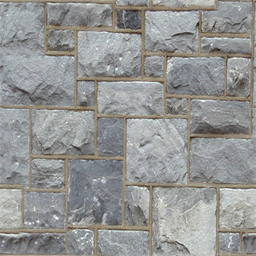
用于上一张纹理的法线贴图如下图所示:
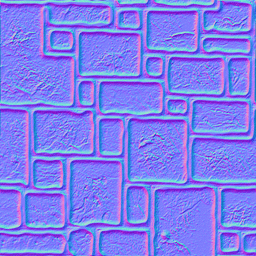
使用法线映射之后,生成的效果如下图所示:
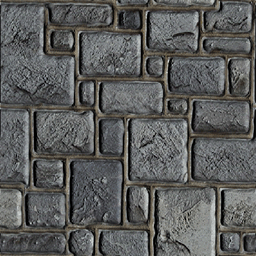
如你所见,视觉效果变得更为真实。比起用更多的多边形,使用法线贴图能用小得多的开销达到同样的效果。
要创建法线贴图,通常需要别人生成一个3D模型,然后使用工具将这个3D模型表面转换为法线贴图。还有些工具可以将2D纹理处理成不错的法线贴图,但是没有从3D模型转换而来的那么精确。
创建法线贴图的工具会将x,y,z坐标转换为red,green,blue像素,分别代表三个矢量的方向,多边形的法线计算方法仍和以前相同,而切线和副法线的计算需要顶点和纹理坐标的信息。下图表示了三个矢量的方向:

法线指向观察者,而切线和副法线位于多边形表面,切线沿x轴,副法线沿y轴,然后两者直接转换到法线贴图的tu和tv纹理坐标,其中纹理的U坐标映射切线,纹理V坐标映射副法线。
我们需要使用法线和纹理坐标事先计算切线和副法线矢量。注意不要在shader中进行这个操作,因为浮点计算是非常耗时的,我在加载模型的时候用C++代码编写了一个函数进行以上的工作。如果你需要在一个多边形数量很大的模型上施加凹凸映射,那么做好事先计算这三个矢量并将它们存储到你的模型格式中去。有了事先计算的切线和副法线,你就可以使用下面的方程确定任意像素的法线了。
bumpNormal = normal + bumpMap.x * tangent + bumpMap.y * binormal;
有了每个像素的法线,我们就可以进一步根据光照方向、颜色纹理确定最终的输出颜色。
框架
本教程使用的框架如下图所示,新的类为BumpMapShaderClass。
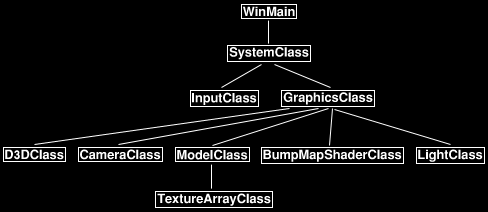
首先看一下bump map HLSL shader代码:
Bumpmap.fx
//////////////////////////////////////////////////////////////////////////////// // Filename: bumpmap.fx //////////////////////////////////////////////////////////////////////////////// ///////////// // GLOBALS // ///////////// matrix worldMatrix; matrix viewMatrix; matrix projectionMatrix;
bump map shader需要两张纹理,数组中的第一张纹理为颜色纹理,第二张为法线贴图。
Texture2D shaderTextures[2];
需要光照方向和颜色用于光照计算。
float4 diffuseColor;
float3 lightDirection;
///////////////////
// SAMPLE STATES //
///////////////////
SamplerState SampleType
{
Filter = MIN_MAG_MIP_LINEAR;
AddressU = Wrap;
AddressV = Wrap;
};
VertexInputType和PixelInputType都有了切线和副法线矢量用于法线映射的计算。
//////////////
// TYPEDEFS //
//////////////
struct VertexInputType
{
float4 position : POSITION;
float2 tex : TEXCOORD0;
float3 normal : NORMAL;
float3 tangent : TANGENT;
float3 binormal : BINORMAL;
};
struct PixelInputType
{
float4 position : SV_POSITION;
float2 tex : TEXCOORD0;
float3 normal : NORMAL;
float3 tangent : TANGENT;
float3 binormal : BINORMAL;
};
////////////////////////////////////////////////////////////////////////////////
// Vertex Shader
////////////////////////////////////////////////////////////////////////////////
PixelInputType BumpMapVertexShader(VertexInputType input)
{
PixelInputType output;
// Change the position vector to be 4 units for proper matrix calculations.
input.position.w = 1.0f;
// Calculate the position of the vertex against the world, view, and projection matrices.
output.position = mul(input.position, worldMatrix);
output.position = mul(output.position, viewMatrix);
output.position = mul(output.position, projectionMatrix);
// Store the texture coordinates for the pixel shader.
output.tex = input.tex;
// Calculate the normal vector against the world matrix only and then normalize the final value.
output.normal = mul(input.normal, (float3x3)worldMatrix);
output.normal = normalize(output.normal);
输入的切线和副法线都会乘以世界矩阵并进行归一化。
// Calculate the tangent vector against the world matrix only and then normalize the final value.
output.tangent = mul(input.tangent, (float3x3)worldMatrix);
output.tangent = normalize(output.tangent);
// Calculate the binormal vector against the world matrix only and then normalize the final value.
output.binormal = mul(input.binormal, (float3x3)worldMatrix);
output.binormal = normalize(output.binormal);
return output;
}
在像素着色器中,我们首先采样颜色纹理和法线贴图的像素,然后将法线贴图的值乘以2再减1使这个值的范围变为-1.0到+1.0,做这一步的原因是纹理坐标的范围是0.0到+1.0,只是法线值的一半,所以需要进行映射。之后,我们就使用前面提到的方程计算映射法线,经过归一化后的法线与光照方向进行点乘后就得出了光照强度,最后使用这个光照强度、光照颜色和纹理颜色获取最终的像素颜色。
////////////////////////////////////////////////////////////////////////////////
// Pixel Shader
////////////////////////////////////////////////////////////////////////////////
float4 BumpMapPixelShader(PixelInputType input) : SV_Target
{
float4 textureColor;
float4 bumpMap;
float3 bumpNormal;
float3 lightDir;
float lightIntensity;
float4 color;
// Sample the texture pixel at this location.
textureColor = shaderTextures[0].Sample(SampleType, input.tex);
// Sample the pixel in the bump map.
bumpMap = shaderTextures[1].Sample(SampleType, input.tex);
// Expand the range of the normal value from (0, +1) to (-1, +1).
bumpMap = (bumpMap * 2.0f) - 1.0f;
// Calculate the normal from the data in the bump map.
bumpNormal = input.normal + bumpMap.x * input.tangent + bumpMap.y * input.binormal;
// Normalize the resulting bump normal.
bumpNormal = normalize(bumpNormal);
// Invert the light direction for calculations.
lightDir = -lightDirection;
// Calculate the amount of light on this pixel based on the bump map normal value.
lightIntensity = saturate(dot(bumpNormal, lightDir));
// Determine the final diffuse color based on the diffuse color and the amount of light intensity.
color = saturate(diffuseColor * lightIntensity);
// Combine the final bump light color with the texture color.
//color = color * textureColor;
return color;
}
////////////////////////////////////////////////////////////////////////////////
// Technique
////////////////////////////////////////////////////////////////////////////////
technique10 BumpMapTechnique
{
pass pass0
{
SetVertexShader(CompileShader(vs_4_0, BumpMapVertexShader()));
SetPixelShader(CompileShader(ps_4_0, BumpMapPixelShader()));
SetGeometryShader(NULL);
}
}
Bumpmapshaderclass.h
BumpMapShaderClass只是上一个教程shader类的修改版本。
////////////////////////////////////////////////////////////////////////////////
// Filename: bumpmapshaderclass.h
////////////////////////////////////////////////////////////////////////////////
#ifndef _BUMPMAPSHADERCLASS_H_
#define _BUMPMAPSHADERCLASS_H_
//////////////
// INCLUDES //
//////////////
#include <d3d10.h>
#include <d3dx10.h>
#include <fstream>
using namespace std;
////////////////////////////////////////////////////////////////////////////////
// Class name: BumpMapShaderClass
////////////////////////////////////////////////////////////////////////////////
class BumpMapShaderClass
{
public:
BumpMapShaderClass();
BumpMapShaderClass(const BumpMapShaderClass&);
~BumpMapShaderClass();
bool Initialize(ID3D10Device*, HWND);
void Shutdown();
void Render(ID3D10Device*, int, D3DXMATRIX, D3DXMATRIX, D3DXMATRIX, ID3D10ShaderResourceView**, D3DXVECTOR3, D3DXVECTOR4);
private:
bool InitializeShader(ID3D10Device*, HWND, WCHAR*);
void ShutdownShader();
void OutputShaderErrorMessage(ID3D10Blob*, HWND, WCHAR*);
void SetShaderParameters(D3DXMATRIX, D3DXMATRIX, D3DXMATRIX, ID3D10ShaderResourceView**, D3DXVECTOR3, D3DXVECTOR4);
void RenderShader(ID3D10Device*, int);
private:
ID3D10Effect* m_effect;
ID3D10EffectTechnique* m_technique;
ID3D10InputLayout* m_layout;
ID3D10EffectMatrixVariable* m_worldMatrixPtr;
ID3D10EffectMatrixVariable* m_viewMatrixPtr;
ID3D10EffectMatrixVariable* m_projectionMatrixPtr;
bump map shader需要指向纹理数组,光照方向和颜色的指针。
ID3D10EffectShaderResourceVariable* m_textureArrayPtr; ID3D10EffectVectorVariable* lightDirectionPtr; ID3D10EffectVectorVariable* diffuseColorPtr; }; #endif
Bumpmapshaderclass.cpp
////////////////////////////////////////////////////////////////////////////////
// Filename: bumpmapshaderclass.cpp
////////////////////////////////////////////////////////////////////////////////
#include "bumpmapshaderclass.h"
BumpMapShaderClass::BumpMapShaderClass()
{
m_effect = 0;
m_technique = 0;
m_layout = 0;
m_worldMatrixPtr = 0;
m_viewMatrixPtr = 0;
m_projectionMatrixPtr = 0;
在构造函数中将纹理数组、光照方向和颜色初始化为null。
m_textureArrayPtr = 0;
lightDirectionPtr = 0;
diffuseColorPtr = 0;
}
BumpMapShaderClass::BumpMapShaderClass(const BumpMapShaderClass& other)
{
}
BumpMapShaderClass::~BumpMapShaderClass()
{
}
Initialize方法加载bump map HLSL文件。
bool BumpMapShaderClass::Initialize(ID3D10Device* device, HWND hwnd)
{
bool result;
// Initialize the shader that will be used to draw the triangles.
result = InitializeShader(device, hwnd, L"../Engine/bumpmap.fx");
if(!result)
{
return false;
}
return true;
}
Shutdown释放shader effect。
void BumpMapShaderClass::Shutdown()
{
// Shutdown the shader effect.
ShutdownShader();
return;
}
Render中首先设置shader参数,然后使用bump map shader绘制模型。
void BumpMapShaderClass::Render(ID3D10Device* device, int indexCount, D3DXMATRIX worldMatrix, D3DXMATRIX viewMatrix,
D3DXMATRIX projectionMatrix, ID3D10ShaderResourceView** textureArray, D3DXVECTOR3 lightDirection,
D3DXVECTOR4 diffuseColor)
{
// Set the shader parameters that it will use for rendering.
SetShaderParameters(worldMatrix, viewMatrix, projectionMatrix, textureArray, lightDirection, diffuseColor);
// Now render the prepared buffers with the shader.
RenderShader(device, indexCount);
return;
}
InitializeShader创建bump map shader。
bool BumpMapShaderClass::InitializeShader(ID3D10Device* device, HWND hwnd, WCHAR* filename)
{
HRESULT result;
ID3D10Blob* errorMessage;
polygon layout现在包含五个元素,包含了切线和副法线。
D3D10_INPUT_ELEMENT_DESC polygonLayout[5];
unsigned int numElements;
D3D10_PASS_DESC passDesc;
// Initialize the error message.
errorMessage = 0;
// Load the shader in from the file.
result = D3DX10CreateEffectFromFile(filename, NULL, NULL, "fx_4_0", D3D10_SHADER_ENABLE_STRICTNESS, 0,
device, NULL, NULL, &m_effect, &errorMessage, NULL);
if(FAILED(result))
{
// If the shader failed to compile it should have writen something to the error message.
if(errorMessage)
{
OutputShaderErrorMessage(errorMessage, hwnd, filename);
}
// If there was nothing in the error message then it simply could not find the shader file itself.
else
{
MessageBox(hwnd, filename, L"Missing Shader File", MB_OK);
}
return false;
}
Technique名称修改为BumpMapTechnique。
// Get a pointer to the technique inside the shader.
m_technique = m_effect->GetTechniqueByName("BumpMapTechnique");
if(!m_technique)
{
return false;
}
// Now setup the layout of the data that goes into the shader.
// This setup needs to match the VertexType stucture in the ModelClass and in the shader.
polygonLayout[0].SemanticName = "POSITION";
polygonLayout[0].SemanticIndex = 0;
polygonLayout[0].Format = DXGI_FORMAT_R32G32B32_FLOAT;
polygonLayout[0].InputSlot = 0;
polygonLayout[0].AlignedByteOffset = 0;
polygonLayout[0].InputSlotClass = D3D10_INPUT_PER_VERTEX_DATA;
polygonLayout[0].InstanceDataStepRate = 0;
polygonLayout[1].SemanticName = "TEXCOORD";
polygonLayout[1].SemanticIndex = 0;
polygonLayout[1].Format = DXGI_FORMAT_R32G32_FLOAT;
polygonLayout[1].InputSlot = 0;
polygonLayout[1].AlignedByteOffset = D3D10_APPEND_ALIGNED_ELEMENT;
polygonLayout[1].InputSlotClass = D3D10_INPUT_PER_VERTEX_DATA;
polygonLayout[1].InstanceDataStepRate = 0;
polygonLayout[2].SemanticName = "NORMAL";
polygonLayout[2].SemanticIndex = 0;
polygonLayout[2].Format = DXGI_FORMAT_R32G32B32_FLOAT;
polygonLayout[2].InputSlot = 0;
polygonLayout[2].AlignedByteOffset = D3D10_APPEND_ALIGNED_ELEMENT;
polygonLayout[2].InputSlotClass = D3D10_INPUT_PER_VERTEX_DATA;
polygonLayout[2].InstanceDataStepRate = 0;
layout现在包含了切线和副法线元素,除了语义名称,它们的定义方式与法线相同。
polygonLayout[3].SemanticName = "TANGENT";
polygonLayout[3].SemanticIndex = 0;
polygonLayout[3].Format = DXGI_FORMAT_R32G32B32_FLOAT;
polygonLayout[3].InputSlot = 0;
polygonLayout[3].AlignedByteOffset = D3D10_APPEND_ALIGNED_ELEMENT;
polygonLayout[3].InputSlotClass = D3D10_INPUT_PER_VERTEX_DATA;
polygonLayout[3].InstanceDataStepRate = 0;
polygonLayout[4].SemanticName = "BINORMAL";
polygonLayout[4].SemanticIndex = 0;
polygonLayout[4].Format = DXGI_FORMAT_R32G32B32_FLOAT;
polygonLayout[4].InputSlot = 0;
polygonLayout[4].AlignedByteOffset = D3D10_APPEND_ALIGNED_ELEMENT;
polygonLayout[4].InputSlotClass = D3D10_INPUT_PER_VERTEX_DATA;
polygonLayout[4].InstanceDataStepRate = 0;
// Get a count of the elements in the layout.
numElements = sizeof(polygonLayout) / sizeof(polygonLayout[0]);
// Get the description of the first pass described in the shader technique.
m_technique->GetPassByIndex(0)->GetDesc(&passDesc);
// Create the input layout.
result = device->CreateInputLayout(polygonLayout, numElements, passDesc.pIAInputSignature, passDesc.IAInputSignatureSize,
&m_layout);
if(FAILED(result))
{
return false;
}
// Get pointers to the three matrices inside the shader so we can update them from this class.
m_worldMatrixPtr = m_effect->GetVariableByName("worldMatrix")->AsMatrix();
m_viewMatrixPtr = m_effect->GetVariableByName("viewMatrix")->AsMatrix();
m_projectionMatrixPtr = m_effect->GetVariableByName("projectionMatrix")->AsMatrix();
下面的代码获取纹理数组,光线方向,光线颜色的指针。
// Get pointer to the texture array resource inside the shader.
m_textureArrayPtr = m_effect->GetVariableByName("shaderTextures")->AsShaderResource();
// Get a pointer to the light direction and color variables inside the shader.
lightDirectionPtr = m_effect->GetVariableByName("lightDirection")->AsVector();
diffuseColorPtr = m_effect->GetVariableByName("diffuseColor")->AsVector();
return true;
}
ShutdownShader方法释放所有在InitializeShader方法中创建的对象。
void BumpMapShaderClass::ShutdownShader()
{
// Release the light pointers.
lightDirectionPtr = 0;
diffuseColorPtr = 0;
// Release the pointer to the texture array in the shader file.
m_textureArrayPtr = 0;
// Release the pointers to the matrices inside the shader.
m_worldMatrixPtr = 0;
m_viewMatrixPtr = 0;
m_projectionMatrixPtr = 0;
// Release the pointer to the shader layout.
if(m_layout)
{
m_layout->Release();
m_layout = 0;
}
// Release the pointer to the shader technique.
m_technique = 0;
// Release the pointer to the shader.
if(m_effect)
{
m_effect->Release();
m_effect = 0;
}
return;
}
void BumpMapShaderClass::OutputShaderErrorMessage(ID3D10Blob* errorMessage, HWND hwnd, WCHAR* shaderFilename)
{
char* compileErrors;
unsigned long bufferSize, i;
ofstream fout;
// Get a pointer to the error message text buffer.
compileErrors = (char*)(errorMessage->GetBufferPointer());
// Get the length of the message.
bufferSize = errorMessage->GetBufferSize();
// Open a file to write the error message to.
fout.open("shader-error.txt");
// Write out the error message.
for(i=0; i<bufferSize; i++)
{
fout << compileErrors[i];
}
// Close the file.
fout.close();
// Release the error message.
errorMessage->Release();
errorMessage = 0;
// Pop a message up on the screen to notify the user to check the text file for compile errors.
MessageBox(hwnd, L"Error compiling shader. Check shader-error.txt for message.", shaderFilename, MB_OK);
return;
}
SetShaderParameters方法设置shader参数。
void BumpMapShaderClass::SetShaderParameters(D3DXMATRIX worldMatrix, D3DXMATRIX viewMatrix, D3DXMATRIX projectionMatrix,
ID3D10ShaderResourceView** textureArray, D3DXVECTOR3 lightDirection,
D3DXVECTOR4 diffuseColor)
{
// Set the world matrix variable inside the shader.
m_worldMatrixPtr->SetMatrix((float*)&worldMatrix);
// Set the view matrix variable inside the shader.
m_viewMatrixPtr->SetMatrix((float*)&viewMatrix);
// Set the projection matrix variable inside the shader.
m_projectionMatrixPtr->SetMatrix((float*)&projectionMatrix);
下面的代码设置纹理数组,此数组包含两张纹理,第一张为颜色纹理,第二张为法线贴图。
// Bind the texture array. m_textureArrayPtr->SetResourceArray(textureArray, 0, 2);
下面的代码设置光照方向和颜色。
// Set the direction of the light.
lightDirectionPtr->SetFloatVector((float*)&lightDirection);
// Set the diffuse color of the light.
diffuseColorPtr->SetFloatVector((float*)&diffuseColor);
return;
}
RenderShader方法使用bump map shader绘制模型。
void BumpMapShaderClass::RenderShader(ID3D10Device* device, int indexCount)
{
D3D10_TECHNIQUE_DESC techniqueDesc;
unsigned int i;
// Set the input layout.
device->IASetInputLayout(m_layout);
// Get the description structure of the technique from inside the shader so it can be used for rendering.
m_technique->GetDesc(&techniqueDesc);
// Go through each pass in the technique (should be just one currently) and render the triangles.
for(i=0; i<techniqueDesc.Passes; ++i)
{
m_technique->GetPassByIndex(i)->Apply(0);
device->DrawIndexed(indexCount, 0, 0);
}
return;
}
Modelclass.h
////////////////////////////////////////////////////////////////////////////////
#ifndef _MODELCLASS_H_
#define _MODELCLASS_H_
//////////////
// INCLUDES //
//////////////
#include <fstream>
using namespace std;
///////////////////////
// MY CLASS INCLUDES //
///////////////////////
#include "texturearrayclass.h"
////////////////////////////////////////////////////////////////////////////////
// Class name: ModelClass
////////////////////////////////////////////////////////////////////////////////
class ModelClass
{
private:
VertexType结构体新添了切线和副法线矢量。
struct VertexType
{
D3DXVECTOR3 position;
D3DXVECTOR2 texture;
D3DXVECTOR3 normal;
D3DXVECTOR3 tangent;
D3DXVECTOR3 binormal;
};
ModelType结构体也新添了切线和副法线矢量。
struct ModelType
{
float x, y, z;
float tu, tv;
float nx, ny, nz;
float tx, ty, tz;
float bx, by, bz;
};
下面两个结构体用于计算切线和副法线。
struct TempVertexType
{
float x, y, z;
float tu, tv;
float nx, ny, nz;
};
struct VectorType
{
float x, y, z;
};
public:
ModelClass();
ModelClass(const ModelClass&);
~ModelClass();
bool Initialize(ID3D10Device*, char*, WCHAR*, WCHAR*);
void Shutdown();
void Render(ID3D10Device*);
int GetIndexCount();
ID3D10ShaderResourceView** GetTextureArray();
private:
bool InitializeBuffers(ID3D10Device*);
void ShutdownBuffers();
void RenderBuffers(ID3D10Device*);
bool LoadTextures(ID3D10Device*, WCHAR*, WCHAR*);
void ReleaseTextures();
bool LoadModel(char*);
void ReleaseModel();
新添了三个法线用于计算切线和副法线。
void CalculateModelVectors(); void CalculateTangentBinormal(TempVertexType, TempVertexType, TempVertexType, VectorType&, VectorType&); void CalculateNormal(VectorType, VectorType, VectorType&); private: ID3D10Buffer *m_vertexBuffer, *m_indexBuffer; int m_vertexCount, m_indexCount; ModelType* m_model; TextureArrayClass* m_TextureArray; }; #endif
Modelclass.cpp
//////////////////////////////////////////////////////////////////////////////// // Filename: modelclass.cpp //////////////////////////////////////////////////////////////////////////////// #include "modelclass.h"
Initialize方法的参数包含两张纹理的文件名称。
bool ModelClass::Initialize(ID3D10Device* device, char* modelFilename, WCHAR* textureFilename1, WCHAR* textureFilename2)
{
bool result;
// Load in the model data.
result = LoadModel(modelFilename);
if(!result)
{
return false;
}
调用新的CalculateModelVectors方法计算切线和副法线,还要重新计算法线矢量。
// Calculate the normal, tangent, and binormal vectors for the model.
CalculateModelVectors();
// Initialize the vertex and index buffer that hold the geometry for the triangle.
result = InitializeBuffers(device);
if(!result)
{
return false;
}
加载两张纹理。
// Load the texture array for this model.
result = LoadTextures(device, textureFilename1, textureFilename2);
if(!result)
{
return false;
}
return true;
}
bool ModelClass::InitializeBuffers(ID3D10Device* device)
{
VertexType* vertices;
unsigned long* indices;
D3D10_BUFFER_DESC vertexBufferDesc, indexBufferDesc;
D3D10_SUBRESOURCE_DATA vertexData, indexData;
HRESULT result;
int i;
// Create the vertex array.
vertices = new VertexType[m_vertexCount];
if(!vertices)
{
return false;
}
// Create the index array.
indices = new unsigned long[m_indexCount];
if(!indices)
{
return false;
}
InitializeBuffers有所改变,顶点数组加载的数据来自于ModelType数组,而ModelType数组现在包含了切线和副法线数据,它们需要复制到顶点数组。
// Load the vertex array and index array with data.
for(i=0; i<m_vertexCount; i++)
{
vertices[i].position = D3DXVECTOR3(m_model[i].x, m_model[i].y, m_model[i].z);
vertices[i].texture = D3DXVECTOR2(m_model[i].tu, m_model[i].tv);
vertices[i].normal = D3DXVECTOR3(m_model[i].nx, m_model[i].ny, m_model[i].nz);
vertices[i].tangent = D3DXVECTOR3(m_model[i].tx, m_model[i].ty, m_model[i].tz);
vertices[i].binormal = D3DXVECTOR3(m_model[i].bx, m_model[i].by, m_model[i].bz);
indices[i] = i;
}
// Set up the description of the vertex buffer.
vertexBufferDesc.Usage = D3D10_USAGE_DEFAULT;
vertexBufferDesc.ByteWidth = sizeof(VertexType) * m_vertexCount;
vertexBufferDesc.BindFlags = D3D10_BIND_VERTEX_BUFFER;
vertexBufferDesc.CPUAccessFlags = 0;
vertexBufferDesc.MiscFlags = 0;
// Give the subresource structure a pointer to the vertex data.
vertexData.pSysMem = vertices;
// Now finally create the vertex buffer.
result = device->CreateBuffer(&vertexBufferDesc, &vertexData, &m_vertexBuffer);
if(FAILED(result))
{
return false;
}
// Set up the description of the index buffer.
indexBufferDesc.Usage = D3D10_USAGE_DEFAULT;
indexBufferDesc.ByteWidth = sizeof(unsigned long) * m_indexCount;
indexBufferDesc.BindFlags = D3D10_BIND_INDEX_BUFFER;
indexBufferDesc.CPUAccessFlags = 0;
indexBufferDesc.MiscFlags = 0;
// Give the subresource structure a pointer to the index data.
indexData.pSysMem = indices;
// Create the index buffer.
result = device->CreateBuffer(&indexBufferDesc, &indexData, &m_indexBuffer);
if(FAILED(result))
{
return false;
}
// Release the arrays now that the vertex and index buffers have been created and loaded.
delete [] vertices;
vertices = 0;
delete [] indices;
indices = 0;
return true;
}
LoadTextures加载颜色纹理和法线贴图。
bool ModelClass::LoadTextures(ID3D10Device* device, WCHAR* filename1, WCHAR* filename2)
{
bool result;
// Create the texture array object.
m_TextureArray = new TextureArrayClass;
if(!m_TextureArray)
{
return false;
}
// Initialize the texture array object.
result = m_TextureArray->Initialize(device, filename1, filename2);
if(!result)
{
return false;
}
return true;
}
CalculateModelVectors生成模型的切线和副法线,并且重新计算法线矢量。它首先计算模型有多少个面(三角形),然后根据每个三角形的三个顶点计算切线、副法线和法线。计算了这三个矢量之后将它们保存到ModelType结构数组中。
void ModelClass::CalculateModelVectors()
{
int faceCount, i, index;
TempVertexType vertex1, vertex2, vertex3;
VectorType tangent, binormal, normal;
// Calculate the number of faces in the model.
faceCount = m_vertexCount / 3;
// Initialize the index to the model data.
index = 0;
// Go through all the faces and calculate the the tangent, binormal, and normal vectors.
for(i=0; i<faceCount; i++)
{
// Get the three vertices for this face from the model.
vertex1.x = m_model[index].x;
vertex1.y = m_model[index].y;
vertex1.z = m_model[index].z;
vertex1.tu = m_model[index].tu;
vertex1.tv = m_model[index].tv;
vertex1.nx = m_model[index].nx;
vertex1.ny = m_model[index].ny;
vertex1.nz = m_model[index].nz;
index++;
vertex2.x = m_model[index].x;
vertex2.y = m_model[index].y;
vertex2.z = m_model[index].z;
vertex2.tu = m_model[index].tu;
vertex2.tv = m_model[index].tv;
vertex2.nx = m_model[index].nx;
vertex2.ny = m_model[index].ny;
vertex2.nz = m_model[index].nz;
index++;
vertex3.x = m_model[index].x;
vertex3.y = m_model[index].y;
vertex3.z = m_model[index].z;
vertex3.tu = m_model[index].tu;
vertex3.tv = m_model[index].tv;
vertex3.nx = m_model[index].nx;
vertex3.ny = m_model[index].ny;
vertex3.nz = m_model[index].nz;
index++;
// Calculate the tangent and binormal of that face.
CalculateTangentBinormal(vertex1, vertex2, vertex3, tangent, binormal);
// Calculate the new normal using the tangent and binormal.
CalculateNormal(tangent, binormal, normal);
// Store the normal, tangent, and binormal for this face back in the model structure.
m_model[index-1].nx = normal.x;
m_model[index-1].ny = normal.y;
m_model[index-1].nz = normal.z;
m_model[index-1].tx = tangent.x;
m_model[index-1].ty = tangent.y;
m_model[index-1].tz = tangent.z;
m_model[index-1].bx = binormal.x;
m_model[index-1].by = binormal.y;
m_model[index-1].bz = binormal.z;
m_model[index-2].nx = normal.x;
m_model[index-2].ny = normal.y;
m_model[index-2].nz = normal.z;
m_model[index-2].tx = tangent.x;
m_model[index-2].ty = tangent.y;
m_model[index-2].tz = tangent.z;
m_model[index-2].bx = binormal.x;
m_model[index-2].by = binormal.y;
m_model[index-2].bz = binormal.z;
m_model[index-3].nx = normal.x;
m_model[index-3].ny = normal.y;
m_model[index-3].nz = normal.z;
m_model[index-3].tx = tangent.x;
m_model[index-3].ty = tangent.y;
m_model[index-3].tz = tangent.z;
m_model[index-3].bx = binormal.x;
m_model[index-3].by = binormal.y;
m_model[index-3].bz = binormal.z;
}
return;
}
CalculateTangentBinormal方法的参数为三角形的三个顶点,经过计算后返回这三个顶点的切线和副法线。
void ModelClass::CalculateTangentBinormal(TempVertexType vertex1, TempVertexType vertex2, TempVertexType vertex3,
VectorType& tangent, VectorType& binormal)
{
float vector1[3], vector2[3];
float tuVector[2], tvVector[2];
float den;
float length;
// Calculate the two vectors for this face.
vector1[0] = vertex2.x - vertex1.x;
vector1[1] = vertex2.y - vertex1.y;
vector1[2] = vertex2.z - vertex1.z;
vector2[0] = vertex3.x - vertex1.x;
vector2[1] = vertex3.y - vertex1.y;
vector2[2] = vertex3.z - vertex1.z;
// Calculate the tu and tv texture space vectors.
tuVector[0] = vertex2.tu - vertex1.tu;
tvVector[0] = vertex2.tv - vertex1.tv;
tuVector[1] = vertex3.tu - vertex1.tu;
tvVector[1] = vertex3.tv - vertex1.tv;
// Calculate the denominator of the tangent/binormal equation.
den = 1.0f / (tuVector[0] * tvVector[1] - tuVector[1] * tvVector[0]);
// Calculate the cross products and multiply by the coefficient to get the tangent and binormal.
tangent.x = (tvVector[1] * vector1[0] - tvVector[0] * vector2[0]) * den;
tangent.y = (tvVector[1] * vector1[1] - tvVector[0] * vector2[1]) * den;
tangent.z = (tvVector[1] * vector1[2] - tvVector[0] * vector2[2]) * den;
binormal.x = (tuVector[0] * vector2[0] - tuVector[1] * vector1[0]) * den;
binormal.y = (tuVector[0] * vector2[1] - tuVector[1] * vector1[1]) * den;
binormal.z = (tuVector[0] * vector2[2] - tuVector[1] * vector1[2]) * den;
// Calculate the length of this normal.
length = sqrt((tangent.x * tangent.x) + (tangent.y * tangent.y) + (tangent.z * tangent.z));
// Normalize the normal and then store it
tangent.x = tangent.x / length;
tangent.y = tangent.y / length;
tangent.z = tangent.z / length;
// Calculate the length of this normal.
length = sqrt((binormal.x * binormal.x) + (binormal.y * binormal.y) + (binormal.z * binormal.z));
// Normalize the normal and then store it
binormal.x = binormal.x / length;
binormal.y = binormal.y / length;
binormal.z = binormal.z / length;
return;
}
CalculateNormal方法的参数为切线和副法线,经过叉乘计算获取法线矢量。
void ModelClass::CalculateNormal(VectorType tangent, VectorType binormal, VectorType& normal)
{
float length;
// Calculate the cross product of the tangent and binormal which will give the normal vector.
normal.x = (tangent.y * binormal.z) - (tangent.z * binormal.y);
normal.y = (tangent.z * binormal.x) - (tangent.x * binormal.z);
normal.z = (tangent.x * binormal.y) - (tangent.y * binormal.x);
// Calculate the length of the normal.
length = sqrt((normal.x * normal.x) + (normal.y * normal.y) + (normal.z * normal.z));
// Normalize the normal.
normal.x = normal.x / length;
normal.y = normal.y / length;
normal.z = normal.z / length;
return;
}
Graphicsclass.h
//////////////////////////////////////////////////////////////////////////////// // Filename: graphicsclass.h //////////////////////////////////////////////////////////////////////////////// #ifndef _GRAPHICSCLASS_H_ #define _GRAPHICSCLASS_H_ ///////////// // GLOBALS // ///////////// const bool FULL_SCREEN = true; const bool VSYNC_ENABLED = true; const float SCREEN_DEPTH = 1000.0f; const float SCREEN_NEAR = 0.1f; /////////////////////// // MY CLASS INCLUDES // /////////////////////// #include "d3dclass.h" #include "cameraclass.h" #include "modelclass.h"
新的BumpMapShaderClass头文件包含在GraphicsClass头文件中。
#include "bumpmapshaderclass.h"
#include "lightclass.h"
////////////////////////////////////////////////////////////////////////////////
// Class name: GraphicsClass
////////////////////////////////////////////////////////////////////////////////
class GraphicsClass
{
public:
GraphicsClass();
GraphicsClass(const GraphicsClass&);
~GraphicsClass();
bool Initialize(int, int, HWND);
void Shutdown();
bool Frame();
bool Render();
private:
D3DClass* m_D3D;
CameraClass* m_Camera;
ModelClass* m_Model;
新添了BumpMapShaderClass对象。
BumpMapShaderClass* m_BumpMapShader; LightClass* m_Light; }; #endif
Graphicsclass.cpp
////////////////////////////////////////////////////////////////////////////////
// Filename: graphicsclass.cpp
////////////////////////////////////////////////////////////////////////////////
#include "graphicsclass.h"
GraphicsClass::GraphicsClass()
{
m_D3D = 0;
m_Camera = 0;
m_Model = 0;
在构造函数中将BumpMapShaderClass对象初始化为null。
m_BumpMapShader = 0;
m_Light = 0;
}
GraphicsClass::GraphicsClass(const GraphicsClass& other)
{
}
GraphicsClass::~GraphicsClass()
{
}
bool GraphicsClass::Initialize(int screenWidth, int screenHeight, HWND hwnd)
{
bool result;
D3DXMATRIX baseViewMatrix;
// Create the Direct3D object.
m_D3D = new D3DClass;
if(!m_D3D)
{
return false;
}
// Initialize the Direct3D object.
result = m_D3D->Initialize(screenWidth, screenHeight, VSYNC_ENABLED, hwnd, FULL_SCREEN, SCREEN_DEPTH, SCREEN_NEAR);
if(!result)
{
MessageBox(hwnd, L"Could not initialize Direct3D.", L"Error", MB_OK);
return false;
}
// Create the camera object.
m_Camera = new CameraClass;
if(!m_Camera)
{
return false;
}
// Initialize a base view matrix with the camera for 2D user interface rendering.
m_Camera->SetPosition(0.0f, 0.0f, -1.0f);
m_Camera->Render();
m_Camera->GetViewMatrix(baseViewMatrix);
// Create the model object.
m_Model = new ModelClass;
if(!m_Model)
{
return false;
}
ModelClass对象初始化为一个立方体,颜色纹理为stone01.dds,法线贴图为bump01.dds。
// Initialize the model object.
result = m_Model->Initialize(m_D3D->GetDevice(), "../Engine/data/cube.txt", L"../Engine/data/stone01.dds",
L"../Engine/data/bump01.dds");
if(!result)
{
MessageBox(hwnd, L"Could not initialize the model object.", L"Error", MB_OK);
return false;
}
创建并初始化BumpMapShaderClass对象。
// Create the bump map shader object.
m_BumpMapShader = new BumpMapShaderClass;
if(!m_BumpMapShader)
{
return false;
}
// Initialize the bump map shader object.
result = m_BumpMapShader->Initialize(m_D3D->GetDevice(), hwnd);
if(!result)
{
MessageBox(hwnd, L"Could not initialize the bump map shader object.", L"Error", MB_OK);
return false;
}
// Create the light object.
m_Light = new LightClass;
if(!m_Light)
{
return false;
}
光照颜色设置为白色,光照方向设置为正Z轴方向。
// Initialize the light object.
m_Light->SetDiffuseColor(1.0f, 1.0f, 1.0f, 1.0f);
m_Light->SetDirection(0.0f, 0.0f, 1.0f);
return true;
}
void GraphicsClass::Shutdown()
{
// Release the light object.
if(m_Light)
{
delete m_Light;
m_Light = 0;
}
在Shutdown方法中释放BumpMapShaderClass对象。
// Release the bump map shader object.
if(m_BumpMapShader)
{
m_BumpMapShader->Shutdown();
delete m_BumpMapShader;
m_BumpMapShader = 0;
}
// Release the model object.
if(m_Model)
{
m_Model->Shutdown();
delete m_Model;
m_Model = 0;
}
// Release the camera object.
if(m_Camera)
{
delete m_Camera;
m_Camera = 0;
}
// Release the Direct3D object.
if(m_D3D)
{
m_D3D->Shutdown();
delete m_D3D;
m_D3D = 0;
}
return;
}
bool GraphicsClass::Frame()
{
// Set the position of the camera.
m_Camera->SetPosition(0.0f, 0.0f, -5.0f);
return true;
}
bool GraphicsClass::Render()
{
D3DXMATRIX worldMatrix, viewMatrix, projectionMatrix, orthoMatrix;
static float rotation = 0.0f;
// Clear the buffers to begin the scene.
m_D3D->BeginScene(0.0f, 0.0f, 0.0f, 1.0f);
// Generate the view matrix based on the camera's position.
m_Camera->Render();
// Get the world, view, projection, and ortho matrices from the camera and d3d objects.
m_D3D->GetWorldMatrix(worldMatrix);
m_Camera->GetViewMatrix(viewMatrix);
m_D3D->GetProjectionMatrix(projectionMatrix);
m_D3D->GetOrthoMatrix(orthoMatrix);
旋转立方体观察效果。
// Update the rotation variable each frame.
rotation += (float)D3DX_PI * 0.0025f;
if(rotation > 360.0f)
{
rotation -= 360.0f;
}
// Rotate the world matrix by the rotation value.
D3DXMatrixRotationY(&worldMatrix, rotation);
// Put the model vertex and index buffers on the graphics pipeline to prepare them for drawing.
m_Model->Render(m_D3D->GetDevice());
// Render the model using the bump map shader.
m_BumpMapShader->Render(m_D3D->GetDevice(), m_Model->GetIndexCount(), worldMatrix, viewMatrix, projectionMatrix,
m_Model->GetTextureArray(), m_Light->GetDirection(), m_Light->GetDiffuseColor());
// Present the rendered scene to the screen.
m_D3D->EndScene();
return true;
}
总结
使用bump map shader,你可以只用2D纹理就达到细节清晰的场景。
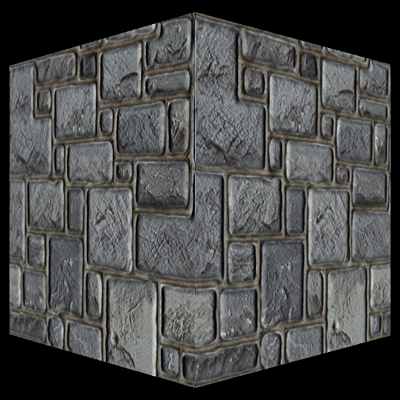
练习
1.编译并运行程序,你会看到一个旋转的立方体,按escape键退出。
2.在像素着色器中注释color = color * textureColor;,看看只有凹凸光照的效果。
3.移动相机和光源位置,从不同角度观察效果。
文件下载(已下载 1114 次)发布时间:2012/8/8 上午12:45:41 阅读次数:8198
